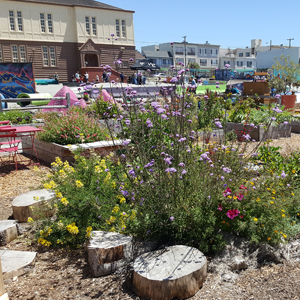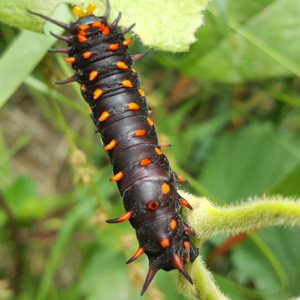
Working with neighbors and local residents, CAN! collaborates with community members to design, raise funds and physically build out community gardens.
Richmond District Neighborhood Center Urban Garden:
Since 2013 CAN! has worked alongside the Richmond District Neighborhood Center and the larger community to create the RDNC Urban Garden. This SFUSD property was once an abandoned hillside full of Acacia trees and weeds. But after four years of CAN! and RDNC investment (and hundreds of hours of work from students and volunteers) the site now boasts over 500 square feet of growing area for organic vegetables, a 25-fruit-tree orchard and contains over 150 species of pollinator-supporting plants.
Student groups explore the garden during the week and community members regularly get dirty planting vegetables and flowers. In 2014 the SF Carbon Fund supported the site by providing funds for the creation of a 25-tree Organic Orchard which now produces apples, lemons, loquat and much more. Visit the site @ 741 30th Avenue at Cabrillo in the Outer Richmond District to experience the garden for yourself.
Playland@43rdAve Community Garden:
Created in partnership with GroundPlay, the SF Planning Department, the Office of District 4 Supervisor Katy Tang, the SFUSD, the SF Parks Alliance and the larger community CAN! created a 26-family community garden in the outer Sunset neighborhood in San Francisco.
This site was once an abandoned parking lot, but now boasts over 100 species of plants full of color and culture, bursting out into the hearts and minds of the community.
The site has nine raised wooden veggie beds, one large octagon herb garden and several straw-bale raised beds. Pollinator Gardens surround the vegetable garden, including a large riparian stormwater management facility planted in native plants. This riparian swale captures the stromwater from the entire parking lot, permitting the rainwater to flow into the ground, replenishing the local aquifer underneath the Sunset neighborhood while building habitat and sequestering carbon from the atmosphere. Check out the riparean garden in wintertime when it fills up with stormwater!
Community activities such as garden workdays, community yoga, table-tennis, basket and an incredibly designed and well-utilized skatepark make the site very popular with kids of all ages.



